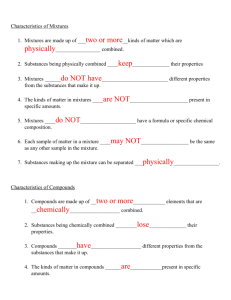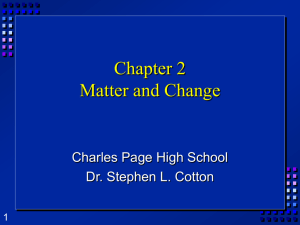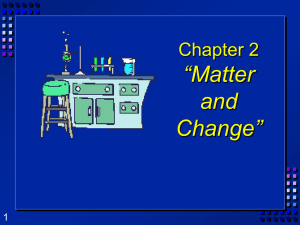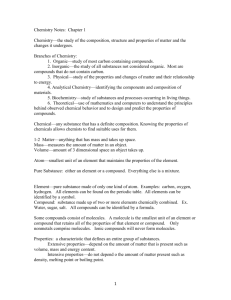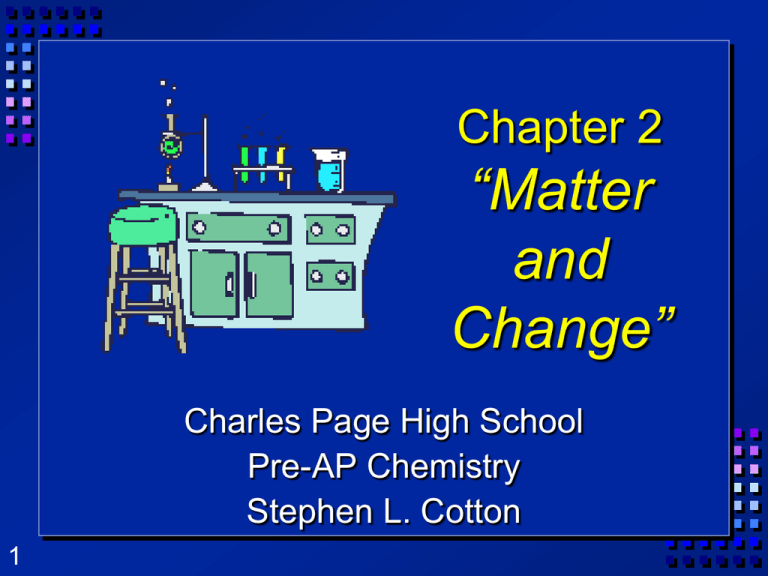
Chapter 2
“Matter
and
Change”
Charles Page High School
Pre-AP Chemistry
Stephen L. Cotton
1
Section 2.1
Properties of Matter
OBJECTIVES:
–Identify properties of matter
as extensive or intensive.
2
Section 2.1
Properties of Matter
OBJECTIVES:
–Define physical property,
and list several common
physical properties of
substances.
3
Section 2.1
Properties of Matter
OBJECTIVES:
–Differentiate among three
states of matter.
4
Section 2.1
Properties of Matter
OBJECTIVES:
–Describe a physical
change.
5
Matter
Matter
is anything that: a) has
mass, and b) takes up space
Mass = a measure of the amount
of “stuff” (or material) the object
contains (don’t confuse this with
weight, a measure of gravity)
Volume = a measure of the space
occupied by the object
6
Weight and Mass Differences
Describing Matter
Properties used to describe matter
can be classified as:
1) Extensive – depends on the
amount of matter in the sample
- Mass, volume, calories are examples
2) Intensive – depends on the type
of matter, not the amount present
- Hardness, Density, Boiling Point
8
Properties are…
Words
that describe matter (adjectives)
Physical Properties- a property that can
be observed and measured without
changing the material’s composition.
Examples- color, hardness, m.p., b.p.
Chemical Properties- a property that
can only be observed by changing the
composition of the material.
Examples- ability to burn, decompose,
ferment, react with, etc.
9
States of matter
1) Solid- matter that can not flow (definite
shape) and has definite volume.
2) Liquid- definite volume but takes the
shape of its container (flows).
3) Gas- a substance without definite volume
or shape and can flow.
– Vapor- a substance that is currently a
gas, but normally is a liquid or solid at
room temperature. (Which is correct:
“water gas”, or “water vapor”?)
10
States of Matter
Definite Definite
Volume? Shape?
Solid
Liquid
Gas
11
YES
YES
NO
Result of a
TemperatureI Will it
Compress?
ncrease?
YES
Small
Expans.
NO
NO
Small
Expans.
NO
NO
Large
Expans.
YES
2.1
> Identifying Substances
Properties of Matter
Slide
12 of 26
© Copyright Pearson Prentice Hall
4th state: Plasma - formed at
high temperatures; ionized phase
of matter as found in the sun
13
Three Main Phases – page 41
14
Condense
Freeze
Evaporate
Melt
Solid
16
Liquid
Heat energy added
Gas
17
How to picture things in your mind.
18
Copper Phases - Solid
19
Copper Phases - Liquid
20
Copper Phases – Vapor (gas)
21
2.1
> Physical Changes
Properties of Matter
During a physical
change, some properties
of a material change, but
the composition of the
material does not change.
As gallium melts in a
person’s hand, the shape
of the sample changes, but
the composition of the
material does not change.
Slide
22 of 26
© Copyright Pearson Prentice Hall
Physical vs. Chemical Change
Physical
change will change the visible
appearance, without changing the
composition of the material.
– Boil, melt, cut, bend, split, crack
– Is boiled water still water?
Can be reversible, or irreversible
Chemical change - a change where a
new form of matter is formed.
– Rust, burn, decompose, ferment
23
Section 2.2
Mixtures
OBJECTIVES:
–Categorize a sample of
matter as a substance or a
mixture.
24
Section 2.2
Mixtures
OBJECTIVES:
–Distinguish between
homogeneous and
heterogeneous samples of
matter.
25
Section 2.2
Mixtures
OBJECTIVES:
–Describe two ways that
components of mixtures can
be separated.
26
Mixtures are a physical blend of at
least two substances; have variable
composition. They can be either:
1) Heterogeneous – the mixture is not
uniform in composition
• Chocolate chip cookie, gravel, soil.
2) Homogeneous - same composition
throughout; called “solutions”
• Kool-aid, air, salt water
Every part keeps it’s own properties.
27
2.2
Mixtures>
Classifying Mixtures
When oil and vinegar are mixed they form layers,
or phases. The oil phase floats on the water
phase.
Slide
28 of 21
© Copyright Pearson Prentice Hall
29
Solutions are homogeneous mixtures
Mixed
molecule by molecule, thus too
small to see the different parts
Can occur between any state of
matter: gas in gas; liquid in gas; gas
in liquid; solid in liquid; solid in solid
(alloys), etc.
Thus, based on the distribution of
their components, mixtures are called
homogeneous or heterogeneous.
30
Phase?
The
term “phase” is used to describe
any part of a sample with uniform
composition of properties.
A homogeneous mixture consists of a
single phase
A heterogeneous mixture consists of
two or more phases.
Note Figure 2.6, page 45
31
Separating Mixtures
Some
can be separated easily by
physical means: rocks and marbles,
iron filings and sulfur (use magnet)
Differences in physical properties
can be used to separate mixtures.
Filtration - separates a solid from
the liquid in a heterogeneous
mixture (by size) – Figure 2.7, page 46
32
Separation of a Mixture
Components of dyes such as ink may be
separated by paper chromatography.
33
Separation of a Mixture
Distillation: takes advantage
of different boiling points.
NaCl boils at 1415 oC
34
Slide
35 of 21
© Copyright Pearson Prentice Hall
Slide
36 of 21
© Copyright Pearson Prentice Hall
Slide
37 of 21
© Copyright Pearson Prentice Hall
Section 2.3
Elements and Compounds
OBJECTIVES:
–Explain the differences
between an element and a
compound.
38
Section 2.3
Elements and Compounds
OBJECTIVES:
–Distinguish between a
substance and a mixture.
39
Section 2.3
Elements and Compounds
OBJECTIVES:
–Identify the chemical
symbols of elements, and
name elements given their
symbols.
40
Substances are
either:
a) elements, or
b) compounds
41
Substances: element or compound
42
Elements- simplest kind of matter
– cannot be broken down any simpler and
still have properties of that element!
– all one kind of atom. (only 1 Capital Letter)
Compounds are substances that can be
broken down only by chemical methods
– when broken down, the pieces have
completely different properties than the
original compound.
– made of two or more atoms, chemically
combined (not just a physical blend!)
Compound vs. Mixture
Compound
43
Mixture
Made of one kind
of material
Made of more than
one kind of material
Made by a
chemical change
Made by a
physical change
Definite
composition
Variable
composition
Which is it?
Mixture
Element
Compound
44
Elements vs. Compounds
Compounds can be broken down
into simpler substances by
chemical means, but elements
cannot.
A “chemical change” is a change
that produces matter with a
different composition than the
original matter.
45
Chemical Change
A change in which one or more
substances are converted into different
substances.
Heat and
light are
often
evidence of
a chemical
change.
46
Properties of Compounds
Quite
different properties than their
component elements.
Due to a CHEMICAL CHANGE, the
resulting compound has new and
different properties:
• Table sugar – carbon, hydrogen,
oxygen
• Sodium chloride – sodium, chlorine
• Water – hydrogen, oxygen
47
Classification of Matter
48
Symbols & Formulas
Currently, there are 117 elements
Elements have a 1 or two letter symbol,
and compounds have a formula.
An element’s first letter always capitalized;
if there is a second letter, it is written
lowercase: B, Ba, C, Ca, H, He
Start
learning the elements names and
symbols listed in Table B.7 on page R53
Some names come from Latin or other
languages; note Table 2.2, page 52
49
Chemical symbols
The
word chlorine comes from the
Greek word chloros which means
greenish-yellow.
Calcium
comes from the Latin word
Calx which means lime. Calcium is a
major component of Limestone.
Polonium is named for Poland, where
Marie Curie (discoverer) was from.
2.3
Elements and
Compounds
> Symbols and Formulas
Each element is represented by a one or twoletter chemical symbol.
Slide
51 of 25
© Copyright Pearson Prentice Hall
Symbols and Formulas
Gold, Silver, and Copper
are among some of the
most rare elements.
Why were they among the
1st to be discovered?
The entire universe is made
up of just 118 elements
arranged in various ways
52
Section 2.4
Chemical Reactions
OBJECTIVES:
–Describe what happens
during a chemical change.
53
Section 2.4
Chemical Reactions
OBJECTIVES:
–Identify four possible clues
that a chemical change has
taken place.
54
Section 2.4
Chemical Reactions
OBJECTIVES:
–Apply the law of
conservation of mass to
chemical reactions.
55
Chemical Changes
The
ability of a substance to undergo
a specific chemical change is called a
chemical property.
• iron plus oxygen forms rust, so the
ability to rust is a chemical property
of iron
During a chemical change (also called
chemical reaction), the composition of
matter always changes.
56
Chemical Reactions are…
When
one or more substances are
changed into new substances.
Reactants- the stuff you start with
Products- what you make
The products will have NEW
PROPERTIES different from the
reactants you started with
Arrow points from the reactants to the
new products
57
Changing Reactants to Products
Chemical
Rxn -
one or more
substances changes into new
substances.
Reactants are located on the LEFT
of a reaction while the Products are
on the RIGHT side
Na + Cl2 NaCl
Reactants
Products
Recognizing Chemical Changes
1) Energy is absorbed or released
(temperature changes hotter or colder) Light
2) Color changes
3) Gas production (bubbling, fizzing, or odor
change; smoke)
4) formation of a precipitate - a solid that
separates out from solution (won’t dissolve)
5) Irreversibility - not easily reversed
But, there are examples of these that are not
chemical – boiling water bubbles, etc.
59
Conservation of Mass
Law
of Conservation of Mass
Mass is neither created or
destroyed in a Chemical
Reaction.
In a Nuclear Reaction there is a
small amount of mass that is
unaccounted for.
Some mass is converted into
energy. E=mc2
60
Conservation of Mass
During
any chemical reaction, the
mass of the products is always equal
to the mass of the reactants.
All the mass can be accounted for:
–Burning of wood results in products
that appear to have less mass as
ashes; where is the rest?
Law
61
of conservation of mass
- Page 55
43.43 g Original mass = 43.43 g Final mass
reactants
63
=
product
1.
2.
4.
3.
2.4
> Chemical Changes
Chemical Reactions
A magnet separates iron from sulfur. This is an
example of a physical change.
Slide
65 of 19
© Copyright Pearson Prentice Hall
66
2.4
> Chemical Changes
Chemical Reactions
A precipitate is a solid that forms and settles out
of a liquid mixture.
Clues to chemical changes have practical
applications.
Slide
67 of 19
© Copyright Pearson Prentice Hall
Precipitate
2.4
> Chemical Changes
Chemical Reactions
A mixture of iron and sulfur is heated. The iron
and sulfur react and form iron sulfide. This is an
example of a chemical change.
Slide
72 of 19
© Copyright Pearson Prentice Hall
73




